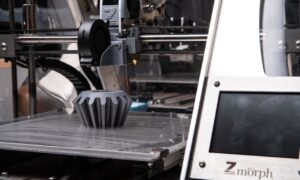The word ‘3D printing’ is a hypernym for creation of 3D objects with the help of various additional approaches to manufacturing. Three dimensional (3D) bioprinting is the usage of printing–like procedures to consolidate cells, development factors, or potentially biomaterials to manufacture biomedical parts, in 3D by copying the characteristics of normal tissues. For the most part, 3D bioprinting can use a layer-by-layer strategy to store materials known as bioinks to make tissue-like constructions that are subsequently utilized in different clinical and tissue designing fields. 3D bioprinting covers an expansive scope of bioprinting strategies and biomaterials.
Cell and Tissue Regeneration Possible in Three Simple Steps
- Pre-bioprinting – Pre-bioprinting is the way toward making a model that the printer will later make and picking the materials that will be utilized. One of the initial steps is to get a biopsy of the organ. Normal advances utilized for bioprinting are figured tomography (CT) and attractive reverberation imaging (MRI). To print with a layer-by-layer approach, tomographic remaking is done on the pictures. The now-2D pictures are then shipped off the printer to be made. When the picture is made, certain cells are detached and duplicated. These cells are then blended in with a unique condensed material that gives oxygen and different supplements to keep them alive. In certain cycles, the cells are typified in cell spheroids 500μm in measurement. This accumulation of cells doesn’t need a framework, and are needed for setting in the rounded tissue combination for cycles like expulsion.
Request Brochure for 3D Bioprinting Market Report
- Bioprinting – 3D bioprinting for creating organic developments normally includes administering cells onto a biocompatible framework utilizing a progressive layer-by-layer way to produce tissue-like three-dimensional designs. Fake organs, for example, 3D bioprinting kidneys and livers have appeared to need significant components that influence the body, for example, working veins, tubules for gathering pee, and the development of billions of cells needed for these organs. Without these parts the body has no real way to get the fundamental supplements and oxygen profound inside their interiors. Given that each tissue in the body is normally made out of various cell types, numerous advancements for printing these phones shift in their capacity to guarantee strength and reasonability of the phones during the assembling interaction. A portion of the strategies that are utilized for 3D bioprinting of cells are photolithography, attractive 3D bioprinting, stereolithography, and direct cell expulsion.
- Post-bioprinting – The post-bioprinting measure is important to make a steady design from the organic material. On the off chance that this interaction isn’t very much kept up, the mechanical respectability and capacity of the 3D printed object is in danger. To keep up the item, both mechanical and compound incitements are required. These incitements convey messages to the cells to control the rebuilding and development of tissues. In recent times, bioreactor advances have permitted the quick development of tissues, tissue vascularization and the capacity to endure transfers.
TMR offers custom market research services that help clients to get information on their business scenario required where syndicated solutions are not enough, request for custom research report
There are a few applications for 3D bioprinting in the clinical field. A newborn child patient with an uncommon respiratory infection known as tracheobronchomalacia (TBM) was given a tracheal brace that was made with 3D printing. 3D bioprinting can be utilized to recreate tissue from different areas of the body. Patients with end-stage bladder illness can be treated by utilizing designed bladder tissues to remake the harmed organ. This innovation can likewise conceivably be applied to muscle tissue, bone, skin, and ligament. In spite of the fact that one long haul objective of 3D bioprinting innovation is to recreate a whole organ, there has been little achievement in printing completely practical organs. In contrast to implantable stents, organs are fundamentally harder to bioprint owing to their complex shapes.



































